Mount Etna Broom Genista aetnensis
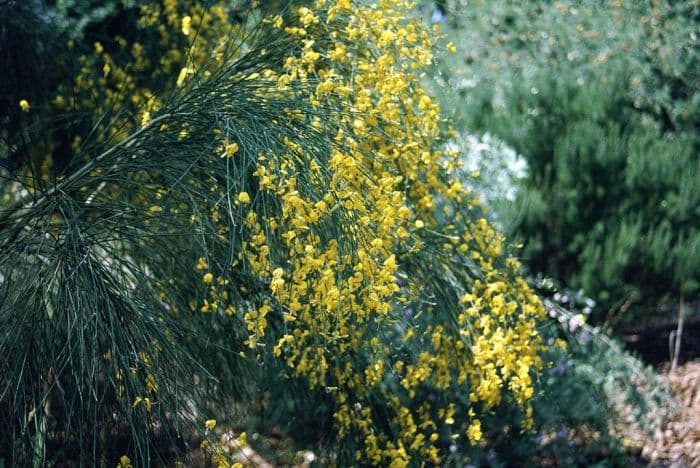
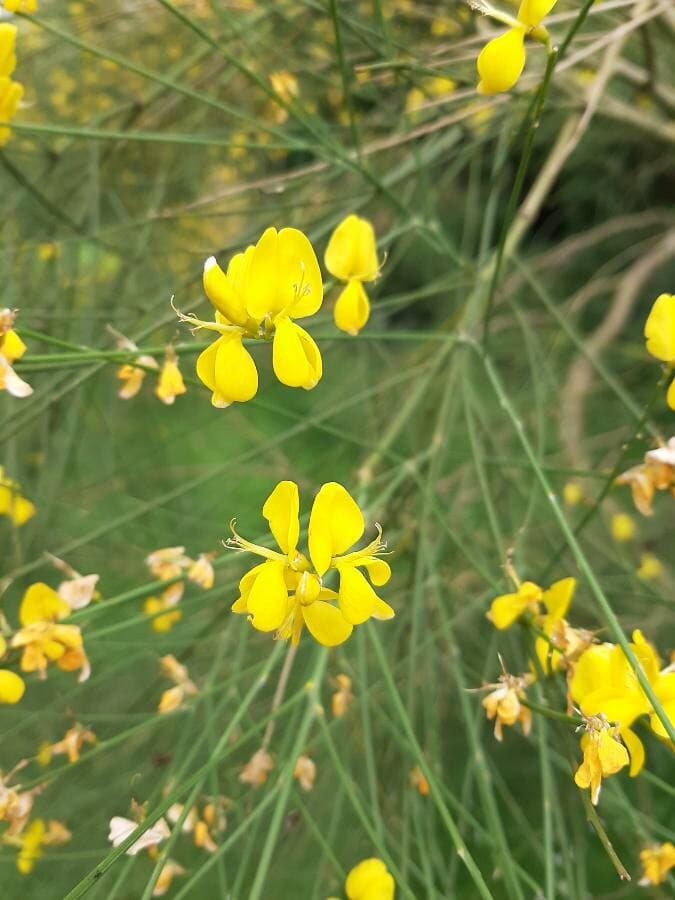
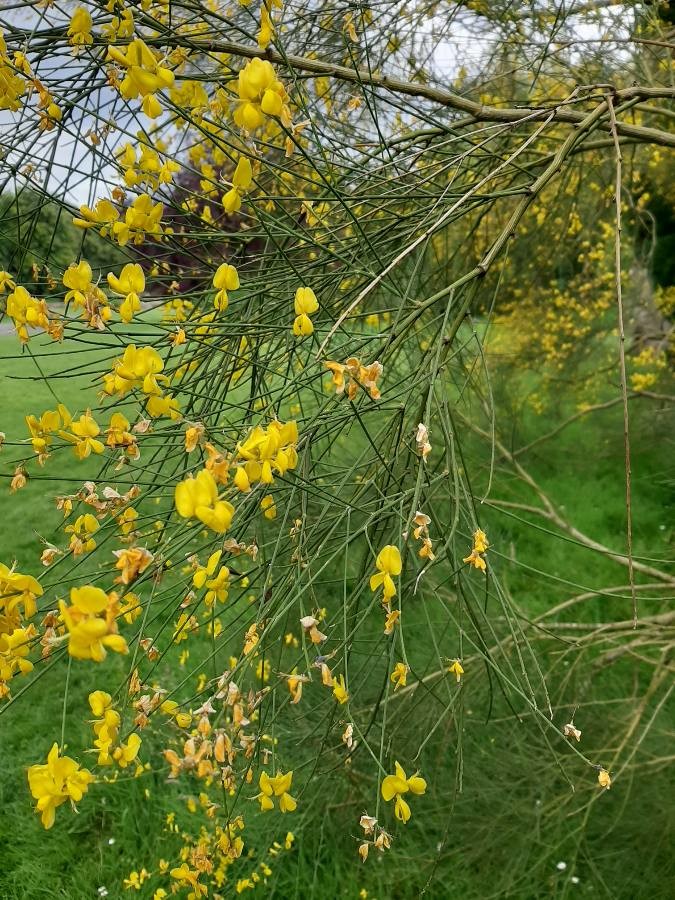
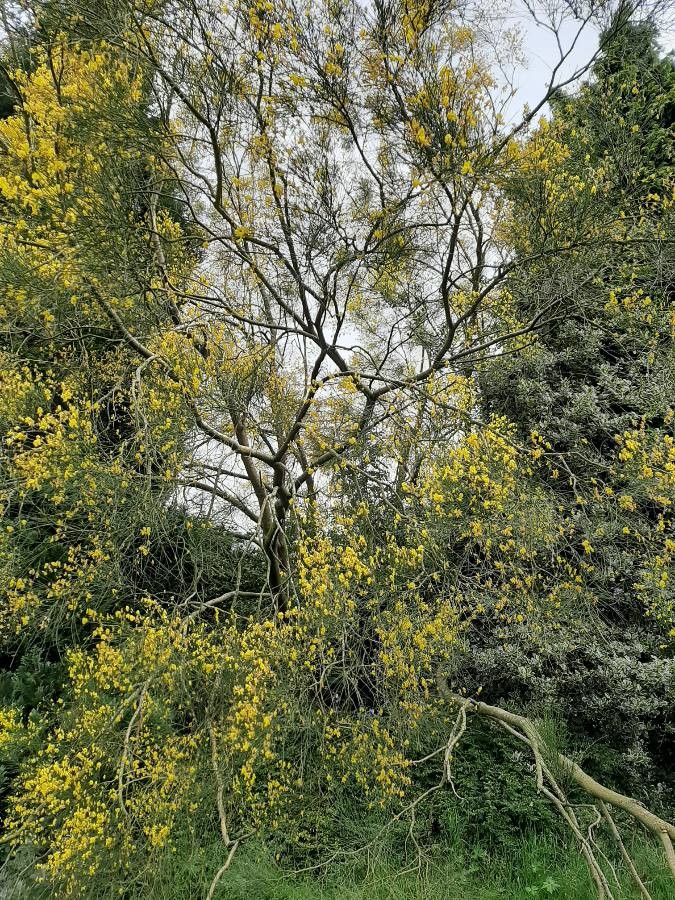
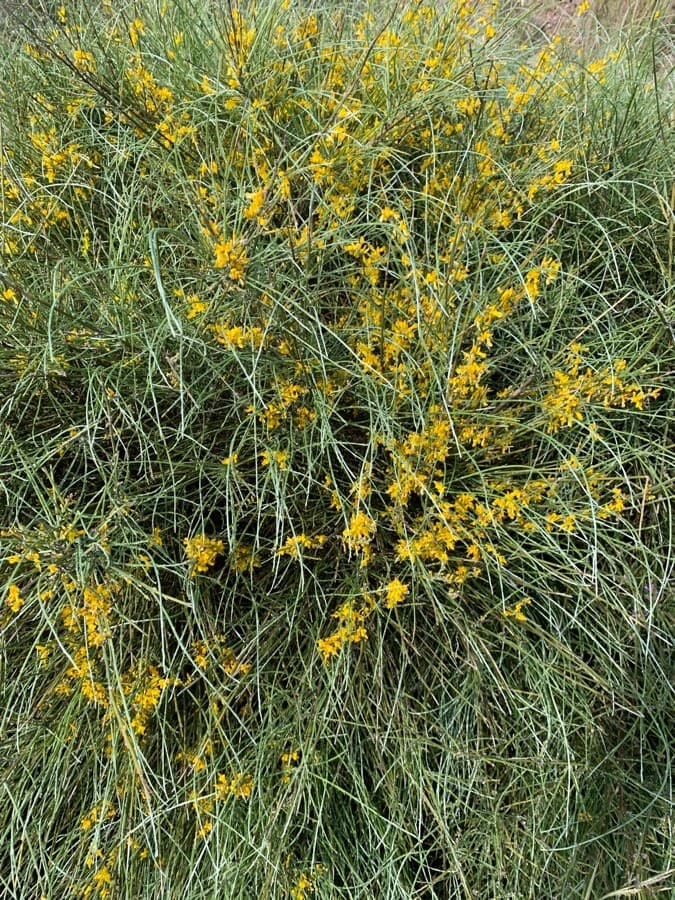
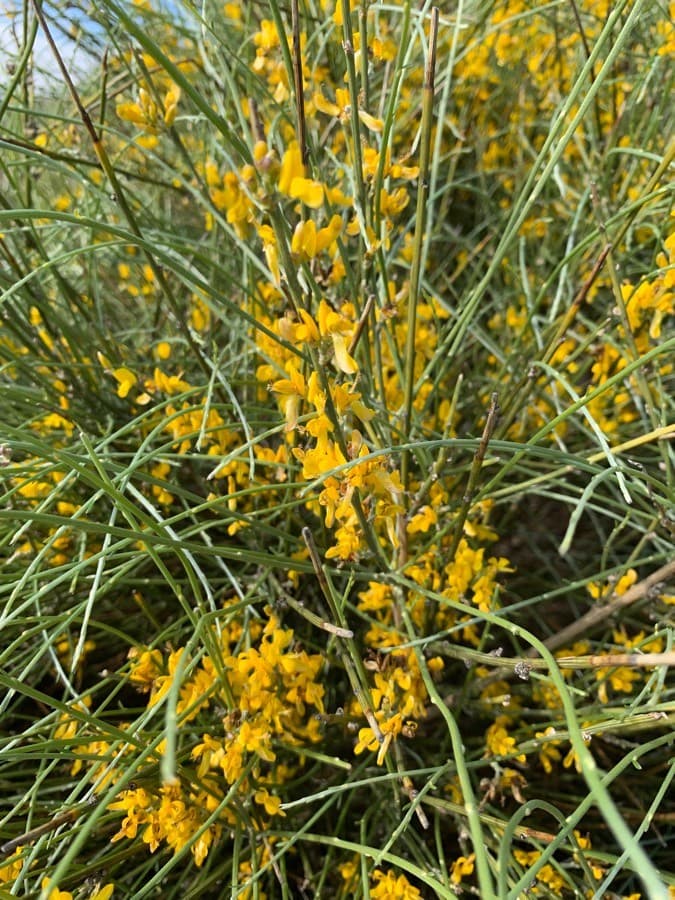
ABOUT
Genista aetnensis, commonly known as Mount Etna broom, is a flowering plant that presents a shrubby and bushy appearance, bearing slender, green stems that might feel somewhat broom-like to the touch. The stems tend to be densely clothed in small, simple leaves which are typically arranged in spirals around the stem; these leaves are often small and may be somewhat needle-like in shape, contributing to the plant's fine-textured visual effect. During blooming periods, the Mount Etna broom is adorned with a profusion of bright yellow flowers, which are rich in nectar and highly attractive to bees. The flowers themselves are pea-like in form, a characteristic common to plants in its family, and they are gathered into dense, tapering clusters that grace the shrub with vibrant splashes of color. Following the flowering phase, the plant will produce seed pods, which mature and crack open to release their contents. The pods typically are a modest size and may be either smooth or slightly textured. The seeds contained within are small and serve as the means by which the plant propagates itself in its natural habitat. The overall visual impression of the Mount Etna broom is one of a feathery, bright, and resilient bush, capable of adding bursts of sunlight-yellow to the landscapes it inhabits, often associated with rocky and volcanic soils where it thrives as an endemic species. Its appearance is reflective of its adaptation to sunny, dry conditions and it can often be seen contributing to the Mediterranean character of the regions it populates.
About this plant
 Names
NamesSynonyms
Mount Etna Broom, Etna Broom, Etna Genista
Common names
Cytisus aetnensis, Genista aetnensis var. aetnensis, Genista aetnensis subsp. aetnensis.
 Toxicity
ToxicityTo humans
Genista aetnensis, commonly known as Mount Etna broom, is considered to be poisonous. It contains quinolizidine alkaloids that can be toxic when ingested. The symptoms of poisoning can vary but typically include nausea, vomiting, and diarrhea. In severe cases, it can lead to neurological symptoms such as dizziness, tremors, and seizures. Ingesting significant amounts of this plant can cause serious consequences and may require medical attention.
To pets
Mount Etna broom is also toxic to pets. It contains the same quinolizidine alkaloids that are harmful to humans. If a pet ingests part of the plant, symptoms may include vomiting, diarrhea, and lethargy. In more severe cases, there could be neurological signs such as tremors or seizures. It is important to prevent pets from ingesting this plant and seek veterinary help if poisoning is suspected.
 Characteristics
CharacteristicsLife cycle
Perennials
Foliage type
Evergreen
Color of leaves
Green
Flower color
Yellow
Height
6 feet (1.83 meters)
Spread
6 feet (1.83 meters)
Plant type
Shrub
Hardiness zones
7
Native area
Sicily
Benefits
 General Benefits
General Benefits- Erosion Control: Genista aetnensis, commonly known as Mount Etna broom, has a robust root system that helps to stabilize soil and prevent erosion on slopes.
- Habitat for Wildlife: It provides shelter and nesting sites for birds as well as a habitat for various insects and small mammals.
- Ornamental Use: With its bright yellow flowers, the Mount Etna broom is valued for its aesthetic appeal in gardens and landscaping projects.
- Drought Resistance: This plant is well-adapted to dry conditions, making it useful for xeriscaping and in areas prone to drought.
- Nitrogen Fixation: As a member of the legume family, it can fix nitrogen in the soil, improving soil fertility without the need for chemical fertilizers.
- Windbreak: The dense growth pattern of Genista aetnensis can act as a windbreak, providing protection for crops, soil, and other plants.
- Low Maintenance: Once established, the Mount Etna broom requires minimal care, making it suitable for low-maintenance landscapes.
 Medical Properties
Medical PropertiesThis plant is not used for medical purposes.
 Air-purifying Qualities
Air-purifying QualitiesThis plant is not specifically known for air purifying qualities.
 Other Uses
Other Uses- Soil Stabilization: Mount Etna Broom's extensive root system can help stabilize soils on slopes and prevent erosion.
- Dye Production: The flowers and other plant parts of Mount Etna Broom can be used to produce a natural dye for textiles.
- Beekeeping: Mount Etna Broom is a potent source of nectar and pollen, providing bee forage which results in a distinctive honey.
- Habitat Restoration: The plant can be used in habitat restoration projects, particularly in its native areas, to support local ecosystems.
- Aesthetic Ornamentation: With its vibrant yellow flowers, Mount Etna Broom is used in ornamental plantings and landscape design.
- Educational Tool: Mount Etna Broom can be used in educational programs about native plants and their role in ecosystem balance.
- Biomass Production: It can be grown for biomass production, which can then be used as a biofuel or in bioenergy applications.
- Cultural Symbolism: In its native region, the plant is sometimes used in cultural ceremonies or as a regional emblem.
- Wildlife Shelter: The dense foliage of Mount Etna Broom provides shelter and nesting sites for various bird species and small mammals.
- Fragrance Source: The flowers of Mount Etna Broom can be used in the manufacture of perfumes or other fragranced products.
Interesting Facts
 Feng Shui
Feng ShuiThe Mount Etna Broom is not used in Feng Shui practice.
 Zodiac Sign Compitability
Zodiac Sign CompitabilityThe Mount Etna Broom is not used in astrology practice.
 Plant Symbolism
Plant Symbolism- Endurance: Genista aetnensis, commonly known as Mount Etna broom, thrives on the volcanic slopes of Mount Etna in Sicily, symbolizing its ability to endure harsh conditions and adversity.
- Protection: The tough nature of this plant serves as a symbol of protection, as it survives in the tough landscape where few other plants can thrive.
- Purification: Brooms, including the Mount Etna broom, have traditionally been associated with cleaning and thus symbolize purification and the sweeping away of negative influences.
- Resilience: The resilience of Genista aetnensis, growing in nutrient-poor, rugged soil, symbolizes strength and the ability to persist despite challenges.
- Renaissance: As a plant that can colonize barren areas, the Mount Etna broom represents rebirth and a fresh start, much like the new life that follows a volcanic eruption.
 Water
WaterMount Etna brooms should be watered thoroughly whenever the soil feels dry to the touch, around once per week in moderate climates. During hot and dry periods, watering frequency may need to increase to twice per week. Provide the plant with about 1-2 gallons of water each time, ensuring you moisten the soil well but avoid waterlogging. During winter, reduce watering to every few weeks, as the plant's water needs decrease significantly.
 Light
LightMount Etna brooms perform best in full sun conditions where they can receive direct sunlight for at least six hours a day. They are well-suited to open, sunny spots in the garden, which will ensure they have the energy to produce their vibrant yellow flowers. Avoid placing them in shady areas as this can impede their growth and flowering.
 Temperature
TemperatureThe Mount Etna broom thrives in a wide range of temperatures and can survive in conditions as low as 10 degrees Fahrenheit, although it is happiest in temperatures between 50 and 80 degrees Fahrenheit. It's a hardy plant that can endure high heat but should be protected from extreme cold below 10 degrees Fahrenheit where possible.
 Pruning
PruningPrune Mount Etna brooms in late winter or early spring to maintain their shape and encourage new growth. Pruning is also necessary to remove any dead or diseased branches. It's best to do this before the plant begins its active growth in the spring.
 Cleaning
CleaningNot needed
 Soil
SoilFor Mount Etna Broom (Genista aetnensis), a well-draining soil mix is essential. Use a combination of loam, peat, and sharp sand to enhance drainage. Adding some pumice or perlite can also increase aeration. This plant prefers a slightly acidic to neutral pH, ranging from 6.0 to 7.5.
 Repotting
RepottingMount Etna Broom should be repotted every 2 to 3 years to prevent becoming root-bound and to replenish nutrients in the soil. It's best to repot in the spring before the growing season begins.
 Humidity & Misting
Humidity & MistingMount Etna Broom prefers a moderate level of humidity and can tolerate the dry conditions often found in a typical home environment. It does not have specific high humidity requirements.
 Suitable locations
Suitable locationsIndoor
Ensure bright light, good air circulation, and avoid overwatering.
Outdoor
Plant in full sun, well-drained soil, and protect from harsh winds.
Hardiness zone
8-10 USDA
 Life cycle
Life cycleGenista aetnensis, commonly known as Mount Etna Broom, starts its life cycle with seed germination, which typically occurs in spring when the soil temperature and moisture conditions are favorable. After germination, the seedling phase begins, characterized by the development of a basic root system and the first true leaves. As the plant grows, it enters the vegetative stage, during which it rapidly increases in size and produces a dense foliage of narrow, dark green leaves. Flowering occurs in the mature plant, usually between late spring and early summer, showcasing vibrant yellow flowers that attract a variety of pollinators. After pollination, the plant develops seed pods, which mature and eventually burst open to disperse seeds, thereby completing the reproductive stage. The plant is perennial and will continue to grow and repeat the flowering and seeding cycle annually.
 Propogation
PropogationPropogation time
Spring-Early Summer
Mount Etna Broom, or Genista aetnensis, is most commonly propagated through its seeds. The best time to sow the seeds is in the fall, just after they have matured. For successful germination, it is often recommended to first scarify the seeds gently by nicking or rubbing them with sandpaper to break their dormancy and then soaking them in warm water for about 24 hours to soften the seed coat. Afterward, the seeds are sowed shallowly, approximately 1/4 inch (about 6 millimeters) deep, in well-draining soil and kept moist until germination, which typically occurs in a few weeks to a couple of months depending on the conditions. Once the seedlings are large enough to handle, usually when they have a couple of sets of true leaves, they can be transplanted into individual pots or their final location in the garden.









